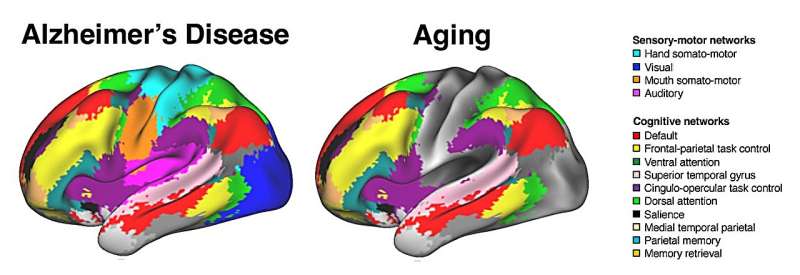This article has been reviewed according to Science X's editorial process and policies. Editors have highlighted the following attributes while ensuring the content's credibility:
fact-checked
peer-reviewed publication
trusted source
proofread
Study reveals broader impact of Alzheimer's on brain function

Scientists at The University of Texas at Dallas Center for Vital Longevity (CVL) have published new evidence that shows changes in brain network patterns that occur in early-stage Alzheimer's disease differ from those associated with normal aging.
The findings, published in The Journal of Neuroscience, also show that the impact of Alzheimer's on brain function is broader than previously believed. In addition to detecting characteristic changes in the brain circuits supporting memory and attention as expected, the researchers found distinct changes in circuits involved in sensory and motor processing.
"Some Alzheimer's disease-accompanied brain dysfunction that goes beyond memory and attention might be detectable at very early stages, even during mild cognitive impairment before a diagnosis of Alzheimer's," said Dr. Gagan Wig, associate professor of psychology in the School of Behavioral and Brain Sciences and corresponding author of the study.
The research team found that the Alzheimer's-related changes in brain networks—interconnected regions of the brain sharing similar functions—were independent of other factors typically associated with the disease, such as elevated levels of amyloid plaques, which form when protein pieces called beta-amyloid clump together.
This brain-network dysfunction could be a new way of characterizing Alzheimer's-related cognitive impairment and provide a target for potential treatment, Wig said.
"We've come to realize that the targets we've been focusing on might not be sufficient, including the idea of amyloid being the primary culprit of Alzheimer's disease," he said. "We've been seeking other ways of quantifying Alzheimer's dysfunction, and in this paper, we show that even when you account for amyloid burden, circuit dysfunction is still there."
Neuroscientists have distinguished brain regions and systems by function for more than a century. Some of these networks govern sensory or motor operations, while other so-called association systems integrate and retain that information and oversee attention, memory and language.
This distinction could play a key role in separating healthy aging from Alzheimer's degradation, Wig said.
"In healthy aging, changes seem largely focused on association systems. Sensory and motor systems are generally stable," Wig said. "For example, the brain of an 80-year-old is very likely to have noticeable atrophy in an association cortex but may have relatively more preserved visual and auditory cortex."
In the study, researchers examined the effects of age and Alzheimer's severity on resting-state brain system segregation, a measure of the brain network's organization and integrity, in 326 cognitively healthy and 275 cognitively impaired individuals who were scanned as part of the Alzheimer's Disease Neuroimaging Initiative (ADNI).
"With the brain-scan data we now have available, we can account for age-related brain differences and observe alterations unique to dementia severity. Exploring this, we found worsening dementia is associated not only with alterations to association systems, but also to the sensory and motor systems," Wig said. "This work would be impossible without the massive, multisite ADNI database that has been made available to Alzheimer's disease researchers such as our group."
Cognition and neuroscience doctoral student Ziwei Zhang, the first author of the paper and a member of Wig's neuroimaging lab, said the network interactions affected in Alzheimer's are a broader group than those affected by healthy aging.
"In older adults who don't show any cognitive impairment, the interactions altered are primarily among brain regions performing similar functions, or within brain systems," she said. "However, in patients diagnosed with Alzheimer's disease, the interactions between regions that perform distinct functions—such as visual processing and memory—are also altered."
Neuroscientists have struggled to explain why some people may have typical Alzheimer's pathologies—amyloid plaques and neurofibrillary, or tau, tangles—yet seem cognitively unaffected.
Wig said the new findings show that the cognitive dysfunction that comes with the disease is likely tied to functional network changes that can be dissociated from amyloid levels.
"These observations offer important clues toward identifying the types of behavioral deficits that are most impacted at early stages of Alzheimer's disease and other forms of dementia," he said. "As we continue to refine the brain network-based biomarkers of Alzheimer's, we are honing in on a new, unique source of information to aid both Alzheimer's diagnosis and for measuring disease risk in otherwise healthy individuals."
More information: Ziwei Zhang et al, Dissociable Effects of Alzheimer's Disease-Related Cognitive Dysfunction and Aging on Functional Brain Network Segregation, The Journal of Neuroscience (2023). DOI: 10.1523/JNEUROSCI.0579-23.2023




















